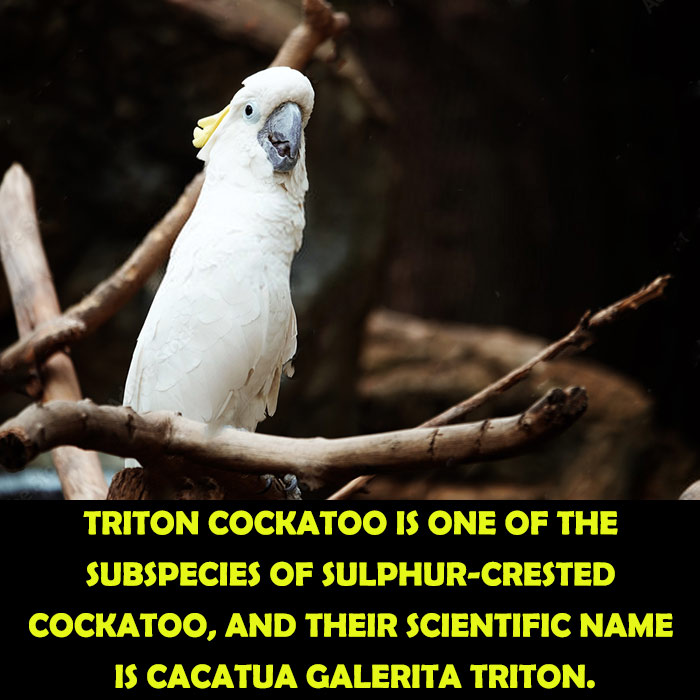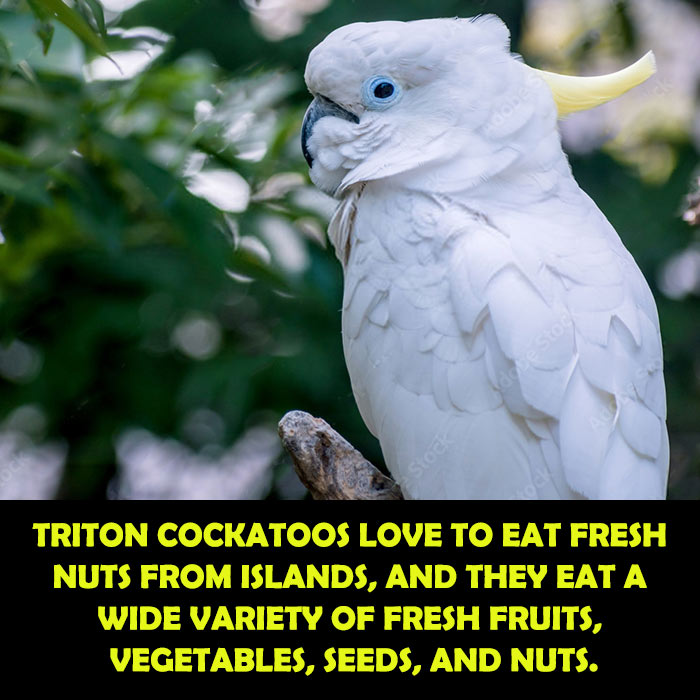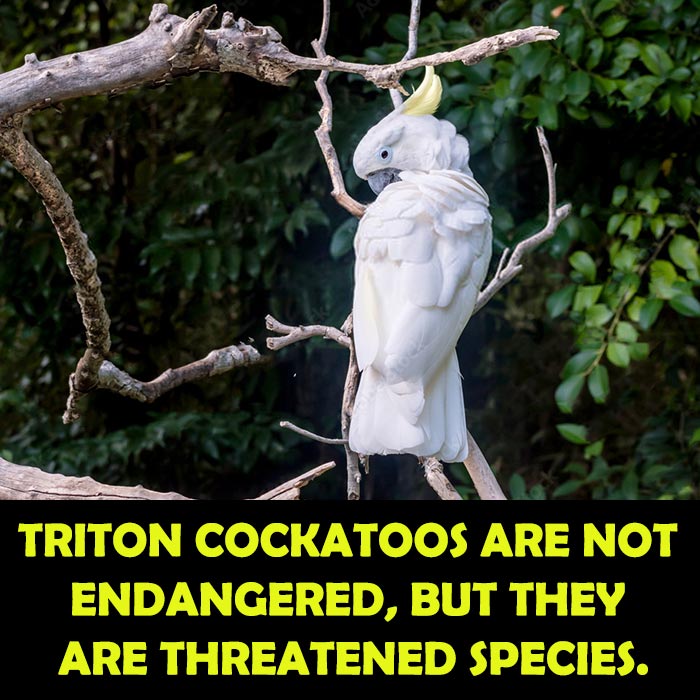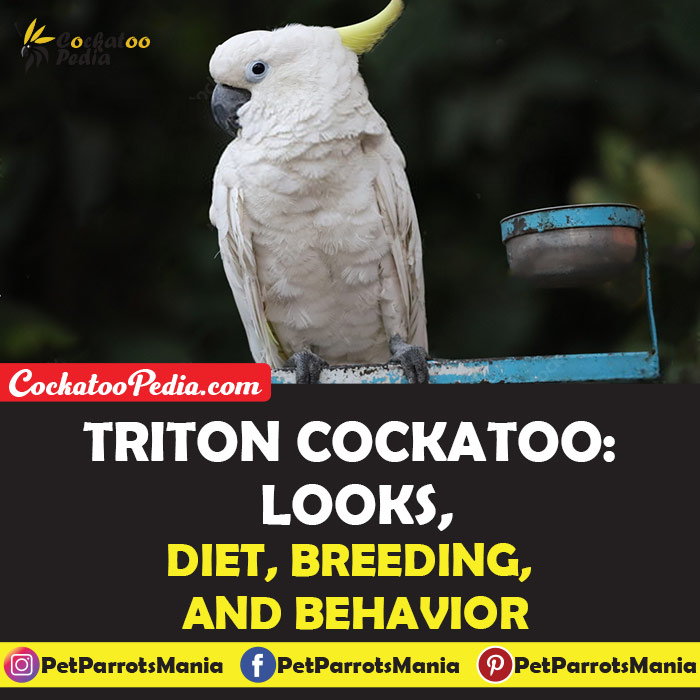Triton Cockatoos are Medium-large Sized, affectionate parrots, and they are the subspecies of Sulphur Crested Cockatoos. They were discovered in 1849, and their scientific name is Cacatua Galerita Triton. They are very intelligent pets, and they are very attached to their owner, which sometimes becomes difficult to handle.
They have larger prominent crests than all species, but they are smaller than Greater Sulphur Crested Cockatoos. They are native to New Guinea, the Western Islands (Papuan), and the Islands of Indonesia. These parrots are arboreal and rarely found in large numbered groups. They are most active in the morning and in the afternoon.
They have a similar appearance to Sulphur Crested Cockatoos and their species, but they have many differences also. The size, appearance, behavior, breeding, and lifespan of the Triton cockatoo will be discussed in this article.
Triton Cockatoo:
Triton Cockatoos are the subspecies of Sulphur Crested Cockatoos, which have broad yellow crests as compared to other ones. They are adorable and intelligent birds, which can learn many words and sentences. They are good at learning and performing tricks.
They are gentle, but during the breeding season, they behave aggressively. Their temperament is a bit like the weather, which changes suddenly. They are considered pests in their natural habitat.
They become very attached to their owner, and sometimes they become very possessive about them. These parrots are very humble, but they attack that person who is disturbing their daily routines, exercises and. Playtime. They are annoyed by that person, which can cause trouble.
Scientific Classification of Triton Cockatoo:
- Scientific Name: Cacatua Galerita Triton
- Common Name: Triton Cockatoo
- Order: Psittaciformes
- Class: Aves
- Kingdom: Animalia
- Genes: Cacatua
- Species: C.Galerita
- Phylum: Chordata
- Family: Cacatuidae
- Subspecies: C.G Galerita
Triton Cockatoo:
Triton Cockatoo is one of the subspecies of Sulphur-crested Cockatoo, and their scientific name is Cacatua Galerita Triton. They are beautiful white parrots with large yellow crests. They are the subspecies of sulphur crested Cockatoos but differ from Greater Sulphur Cockatoo.

They are found in New Guinea and surrounding Islands, and they are a rare parrot species. They are gentle, but during the breeding season, they behave aggressively. They are considered pests in their natural habitat.
They are rarely found in large groups, and they usually fly in pairs or 3 to 4 in numbers. Their lifespan increases in captivity; they can live more than 60 years in captivity. They really get attached to their owners, and they are very sensitive to behaviors.
What Do Triton Cockatoos Look like?
Triton Cockatoos are large, graceful, and affectionate parrots; they have brilliant white plumage. They have an expressive crest, and their feathers lie flat on the top of their head. The color of the crested feathers is yellow, and they are curved upward from their tips.
Triton Cockatoos have a size of about 45 to 55 cm ( 18 to 22 inches), and their weight is about 600 to 800 grams (21 to 28 oz). Like all species of Sulphur Crested Cockatoos, they also have white feathered bodies and yellow crests, but the color of their feathers has some variations.
Unlike other subspecies of Sulfur Crested Cockatoos, they have a Bluish orbital (powdered blue) appearance of skin. Their appearance can be seen in optimal lightning; otherwise, this minute difference can not be observed.
They are dark black beaks that are strong enough to crack the nuts and crush the seeds for eating purposes. They have yellow-tinged feathers on the underwings and under the tail. This yellow color sometimes turns orange, and this slight color variation can be seen in some parrots of the species “Triton Cockatoos.” Their feet are Zygodactylous (Two toes are pointed forward, and the other two toes are pointed backward). They are dark Black in color, and they have dark black legs. They have a large wingspan, and pale blue Periophthalmic ring instead of white.

Mostly male and female, Triton Cockatoos are the adorable, white, iconic Australian parrots. These feet and legs are small in size as compared to their body, and they have rounded tails.
Triton Cockatoo looks alike, but their eye colors are a bit different from each other. Male Triton Cockatoos have Black eyes, and females have dark brown eyes. They both have very attractive white plumage and the same size crest.
Where Do Triton Cockatoos live?
They are native to New Guinea and its surrounding Islands. They usually live on the Islands and forests; the surrounding Islands of New Guinea in which they live are the Western Papuan Islands, Louisiade, and D’Entrecasteaux Islands.
These parrots are fond of Green vegetated areas and Woodlands. They prefer thick jungle forests located on the Hillsides. These Hillsides are most commonly found in lower and moderate Elevations. They are found in those areas in which there are tall trees with fruits, vegetables, and watercourses.
Triton Cockatoos are also found on most of the Islands in the Western area of the Solomon Sea, excluding the Aru Island (Native place of Greater Sulphur Cockatoo). They are often seen flying in small groups and eating in larger groups on the ground.
What Do Triton Cockatoos Eat?
Triton Cockatoos love to eat fresh nuts from Islands, and they eat a wide variety of fresh fruits, vegetables, seeds, and Nuts. They like to eat grain and fresh berries, and more specifically, they want nuts from their favorite tree. They crack and crush the nuts with their strong beaks.
These parrots also eat flowers and flower buds. They also eat insects from the holes of the trees, but in captivity, their diet is not like in the wild. In Captivity, they want a varied diet, and they love to eat fresh, high-quality pellet food.
Their diet must be prepared very well because parrots often suffer from malnutrition. They like fresh vegetables and fruits but never give you parrot Advogados and Apple seeds because they are very harmful to them.

Giving a proper and healthy diet to your pet is very important for their development and growth. A healthy diet affects their feathers’ growth, learning power, and behavior, etc. While eating, they intake some toxic seeds which have harmful chemicals.
These smart parrots can detoxify these chemicals. Triton Cockatoos ingest mineral-enriched clay known as Clay Licks, which protect them from toxic chemicals. These chemicals are bound with clay in their digestive system, and it protects them from toxins.
Size And Weight of Triton Cockatoos:
Triton Cockatoos are considered Medium-Large Parrots, and they have average wingspan. The Length of these parrots is about 45 to 55 cm ( 18 to 22 inches), and they weigh about 600 to 800 grams (21 to 28 oz).
Vocals of Triton Cockatoos:
Triton Cockatoos are extremely loud and noisy parrots. They make (loud) and harsh calls which are mournful too. They produce these calls when they are in Alarming Situations or in danger. During the flight, they produce loud calls and communicate with their fellows.
They also scratch when they are annoyed. They can mimic vocals, sounds of animals and humans and can learn many words and phrases. They are also good at making whistling sounds.
The lifespan of Triton Cockatoos:
The lifespan of Triton Cockatoos is long enough and they can be your long-life partners. Their average lifespan is about 50 to 60 years, and in captivity, if they are cared for properly, they can live more than 60 years.
These beautiful white parrots often get captured or injured in the wild, decreasing their average lifespan. That is why they live more in captivity.
Breeding of Triton Cockatoos:
Triton Cockatoos breed very well in captivity, but in captivity, they need great care because they are imprisoned in the cage. They can not go outside to bring their desired stuff, so everything should be provided to them.

In North America, triton Cockatoos normally breed in winters and in spring. In New Guinea and its surrounding Islands, their breeding season starts from May till September. They are very affectionate parrots and mate for life, and they are monogamous in nature.
During the breeding season, Male Triton Cockatoos become aggressive and often attack female parrots. Sometimes they bite their cheeks, flap their wings, and bite on their legs. There must be separate houses (Boxes) for males and females that in case of any attack, females should escape in the wooden box.
This aggression in male parrots is basically because of Hormonal Changes. In contrast to that, Female parrots seem broody and in a normal mood. They make their nests in cavities of trees and they fill their nests with leaves.
The average clutch size of the female Triton Cockatoo is about two to three eggs. The female incubates the egg for 24 to 26 days, and the chick flees 75 days after hatching. During the breeding season, their behavior becomes quite excited and aggressive. They live with very loud calls, which can create problems for the neighbors in captivity. But in the wild, they freely make loud calls with exciting tones.
Cost of Triton Cockatoo:
Triton Cockatoos are Medium-large parrots, and they are expensive parrots. The cost of an adult Triton Cockatoo is $3000, and the cost of a tamed adult is 4,500. These parrots have less cost than sulfur-crested and have almost similar qualities. The cost of a hand-feed is $1500, and a self-feeding baby cockatoo’s cost is 2,250.
The population of Triton Cockatoo:
Triton Cockatoos are not Endangered, but they are Threatened Species. Their population status is not determined yet, but they are the victims of many issues. They are facing threats from Pet Market, hunters, Habitat loss, etc. Let’s discuss these threats individually in detail.

Triton Cockatoos’ Habitat Loss in New Guinea:
They have a wide population in New Guinea, and its surrounding areas Islands and these areas are under Habitat Loss. Triton Cockatoos live in the thick Jungle jungle forest, and they nest in tall trees. They are facing their habitat loss badly. Trees are rapidly undercutting, and lands are cleared.
This Habitat destruction is because of human activities. They are utilizing the woods from trees and lands for livestock grazing. This utilization of trees and woods is badly affecting the habitat of these graceful parrots.
Moreover, with the devastating effects of habitat destruction, they are also facing natural disasters. Sometimes natural disasters destroy the complete land and its fertility. All trees and plants get cleared because of drought, flood, etc. These are the major threats to them.
Hunting of Triton Cockatoos:
Triton Cockatoos are very charming, their white plumage, attractive Blue orbital skin, and yellow crests make them more eye-catching. These parrots often become the victim of Hunters’ hunting. Hunters hunt to get their meat, and they pluck their feathers for sale purposes.
Due to their unique feathers, they often get captured by the locals and hunters. Their iconic appearance can attract any hunter, and this is a threat to their existence. Nowadays,; their these parrots are facing this threat more commonly.
Illegal Pet trading of Triton Cockatoos:
Triton Cockatoos are highly demanded parrots, and hunting, habitat loss, and pet market trends exert a high pressure, which is leading them to constant threat. These parrots are the victim of Illegal pet trading because of their Iconic white appearance.
They are good pets, So pet traders capture them and sell these parrots at a good cost. Some traders capture them for the trading purpose of their wings. These are the major threats to their existence. Their population is decreasing due to these factors.

Triton Cockatoos as pets:
Triton Cockatoos are extremely affectionate, social, and friendly pets. They are highly social and interactive like other cockatoos are. According to some surveys, they can talk better than other cockatoos. These parrots are very intelligent, and they are quick responders to actions.
They are very quick learners, and they get trained very well after training by their owners. They are Monogamous (they stay with the same mate) lifelong. They seem to be very affectionate birds because of their quality of monogamy.
An interesting fact about these parrots is, they have very excellent learning abilities. They can mimic vocals, sounds of animals and humans. These parrots are very noisy and have harsh vocals. They try to mimic human vocals and repeat their words.
They are very talkative pets that try to mimic the phrases as well as the sounds of the same person. These parrots can do many tricks and dance on the beat when it is played.
These parrots are emotionally complex, and they really get attached to their owner. They have some behavioral issues like most of the parrots have. Sometimes they behave very nicely and on the other minute, they are annoyed.
Conclusion:
Triton Cockatoos are the subspecies of Sulphur Crested Cockatoos, they are similar to other subspecies, but they have different sizes. They are highly demanded and iconic parrots, and they speedily utilize the calories, so they want fatty food. These parrots have very loud vocals and high-pitched calls.
These parrots are beautiful like other subspecies of sulphur-crested Cockatoos but they have some differences. They are different in their size, weight, behavior, breeding, lifespan, and in their conservation status. This article will give you information regarding this all.
Also Read About: Greater Sulphur Crested Cockatoo: Looks, Diet, Breeding, and Behavior

